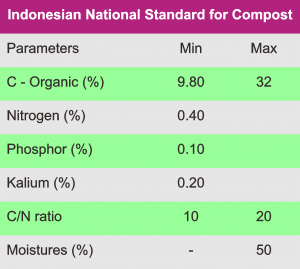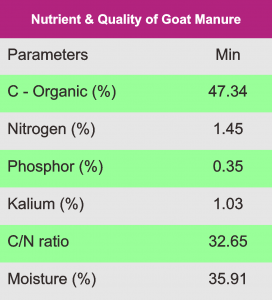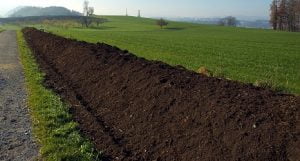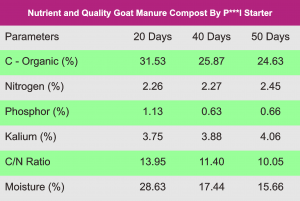How much manure does a goat produce?
Waste from goat farms are many kinds. Among them are goat manure and the remains of inedible goat feed.
This waste is usually not utilized optimally by farmers. Usually this garbage is only collected in somewhere and then burned.
Whereas, if the information can be given appropriately, the use of livestock waste can be very helpful to help the economy even though its amount is not too much.
For example, the nitrogen amount from goat manure as much as 7,434 kg, that is equal to 16,2 kg of urea fertilizer. The nitrogen content of urea is 46%. [1]
Suppose we have some goats. For example 5 heads and each weight is 24 kgs. The total weight becomes 120 kgs.
Each total weight of 120 kgs of goat or sheep, the goat waste produces is approximately 5 kgs. Its consist of 4 kg goat manure and 1 liter of urine.
The dry weight of goat manure is 45%. From 4 kgs of goat manure, we can get dry manure as much as 1.8 kgs.
The nitrogen content of goat manure is 1.6% of the dry weight. While the nitrogen content of urine is 0.6%.
After I count it, every day we will get the nitrogen that is still contained in goat manures as much as 37.8 grams. If a month, just multiplied it by 30 days, So, it would be 1,134 kg.
This amount of nitrogen, just equivalent to 2.5 kgs of urea only.
It is purely from goat manure and urine. The rest of the feed has not been calculated.
Utilization of goat farming waste
Waste from goat farming can actually be utilized to be qood quality compost fertilizer.
This compost, the ingredients can be from pure goat manure or in addition to other organic ingredients. For example the remains of inedible goat feed earlier.
Lots of benefits and advantages when using goat manure into compost.
That is:
Reduce the amount of waste storage farms.
The smell caused by the pile of goat manure can be reduced.
Eliminates the potential pathogens present in livestock manure
Grains that can be weeds will die or will not grow.
Easing in transportation and compost can improve the soil.
Composting goat manure can release nutrients that can be directly utilized by the plants.
Reduce sources of pollution and Economic Value.
These benefits are not limited to goat farms alone. Cattle , buffalo, horses, and sheep can also.
Standard compost quality parameters
Good compost fertilizer should have C/N ratio less than 20. So that, compost fertilizer from goat manure will be better to use when composted first.
Even if it will be used directly, nutrient content can not be utilized by plants.
Manure from goat manure will provide better benefits during the second season of planting.
Or in other words, if fertilized now, the benefits are felt in the next planting period.
According to Indonesian national standard, the quality of organic fertilizer should be like this.
Goat manure composition
While the goat manure, according to a scientific journal [2], the nutritent content and quality standards are still like this.
The C-organic value of goat manure is still very high. Thus, when divided by Nitrogen, the value of the C / N ratio is still high.
In order to keep the C / N ratio low and fertilizer easily absorbed by the plant, the C-Organic content should be reduced.
Naturally, C-organic longer over time will decrease by itself. But this will take a long time.
To be faster, the goat manure needs to be composted. Composting is assisted by bacteria decomposers. For example EM4, Starb * o, Pr ** i, Org ** ec and many others.
Making goat manure compost
Composting from goat droppings has become easier. You see, the bacteria used for starter is easy to get.
In addition, information is easily obtained to make this compost.
Here are some ways to make compost from goat manure. This method is the methods that are done in a study.
First methode making goat manure compost
The first way, the starter used is EM4. If this starter already knows is not it?
This one starter is easy to get. The price is also quite cheap. Per 1 liter bottle cost about IDR 20 thousands.
The steps are as follows.
Mixing goat manure with EM4 starter bacteria.
Before that, activate the Em4 first by mixing em4 with molasses and water.
The ratio of em4, molasses and water is 1: 1: 100.
For example,
1 ml em4: 1 ml molases: 100 ml water or
10 ml em4: 10 ml molasses: 1000 ml of water or 1 liter of water.
Incubate this mixture for two days so that bacteria in em4 are activated.
If using a simple reactor, active bacteria is characterized by the emergence of gas bubbles.
The use dosage of em4 is just like the instructions in the package. One liter of em4 for 1 ton of compost/manure.
If the material of compost is not up to 1 ton, then the dosage should be simplified.
Example:
1 ml em4 to 1 kg of material. So the value will then be equal to (1000 ml = 1 liter) em4 for (1000 kg = 1 ton) of fertilizer.
Furthermore, evenly pour the solution containing em4, molasses and water into the goat manure that will be composted.
Then closed for 5 weeks. Water content from the manure is also considered .
Every three days, the compost is turned back for aeration. This can further accelerate the process. The explanation is below.
The characteristics of suitable moisture content in the making of compost from this goat manure is if the material is clenched, and released, the material is not broken.
In addition, when it clenched does not dripping alot of water.
So, please clench the goat’s manure….. (Peace!)
From some research, there is suggestion to tossing and turning the compost during process but some are not.
Flipping through the composting process is to make composting happen aerobically rather than anaerobically.
Apparently, the result of aerobic composting is better than anaerobic composting.
The advantages of aerobic composting are as follows.
The process is faster. Only about 4-6 weeks. While anaerobic composting can be up to 24 weeks.
Aerobic composting does not produce smelly gas.
The aerobic process gives the effect of fertilizer remains cool or no increase in temperature.
The aerobic process can naturally decompose waste materials containing cellulosic fibers while anaerobic processes can not. [3]
The second way of making compost from goat manure
In this second way, the material that used for making compost is not only from goat manure but there are some additional organic materials.
The second way is like the way done by Suprapto et al, researchers from Lampung Agricultural Technology Assessment Institute that will use compost from goat manure for pepper farming in Lampung.
The ingredients are goat manure while the agricultural waste used is coffee waste, waste sawn, straw and bran.
The steps are as follows:
1. Make a biofermentation solution of molasses and EM-4. Each volume is 250 cc with concentration of 10 cc / 20 liters.
Thus, molasses as much as 250 ml, em4 amount of 10 ml dissolved into water as much as 20 liters.
Then, all mixed stirred until homogeneous or evenly distributed.
2. Agricultural waste is cut into 5 – 10 cm sizes. Then the agricultural wastes consisting of some of the above materials are mixed evenly.
The mixture of agricultural waste is sprinkled with goat droppings until evenly distributed. Furthermore, stacked to form a bed / bund with a width of 2 meters and length 5 – 8 meters.
For this size can be tailored to the needs. Depending on the amount of material owned as well.
This bund and then watered with a solution of biofermentation that has been made on no 1 until evenly distributed.
3. Make a mixture of agricultural waste for the second layer.
The mixture of agricultural waste spread over the first layer, then coated again with other agricultural waste.
Then on it sown again manure until evenly distributed.
Further doused with a solution of biofermentation until wet as the first layer.
4. Steps such as the first and second layers are repeated again in the third layer and so on until the height of the bundle reaches 60-80 cm or the material has run out.
5. Then closed with a dark plastic with a tightly closed and allowed to occur the process of decomposition. Plastic can use mulch plastic.
6. After 10 days, the plastic is opened and the reversal is done. Then restored again and closed plastic as before.
7. After 30-40 days, the heat will go down (cold) and it means that organic fertilizer is finished and ready for use as fertilizer.
The third way of making goat manure compost
This third way uses a different starter from the first and second way. If the first two methods use EM4, this method uses P ** MI and Or * a * ec.
The bacteria contained in this starter is different from the bacteria present in EM4.
The types of bacteria in P ** MI are Trichoderma Harzianium Dt 38, Pseudokoningii Dt 39, Aspergilus sp. and fungi.
While in Or * a * ec, the bacteria are Trichoroderma Pseudokoningii and Cytophaga Sp.
Trichoroderma Pseudokoningii and Cytophaga Sp. According to academic sources it has a tremendous ability to break carbon bonds from organic matter.
So, the use of this type of bacteria when used to make compost from goat manure, the process can be faster.
Twenty days during composting, the quality value of the fertilizer meets the established C/N ratio standard.
Dose usage, for 1 kg of starter can for 1 ton of fertilizer material. How to use is 1 kg diluted to 20 liters of clean water and stirred until evenly distributed.
If the material 0.5 tons, so make it into half only. For example 0.5 kg of starter dissolved to 10 liters of clean water for 500 kg of compost fertilizer.
Research of making compost with Pr**I starter
There is a study that uses a starter of this type of bacteria to make compost from goat manure.
The materials used are goat feces and coconut husk dust. coconut husk dust it is a fragment of the coconut coir process.
If the coconut husk is tied, for example to be made a broom, there must be dust that fall. Well, that’s what is used instead of coir.
The ratio between goat manure and coconut husk dust is 1: 1. If the goat manure is 500 kgs, the dust is also 500 kgs. So, a total of 1 ton.
Then the material was watered with the bacteria had been dissolved. After that, closed and compressed for 50 days.
Every three days the flipping through is regularly done.
The quality of the compost fertilizer produced by numbers can be seen in the following figure.
The longer the composting time, the organic c value decreases and the value of nitrogen increases.
Thus, the value of c / n ratio is smaller and it meets the SNI standard.
Conclusion
#. I do not think it should be idealist or fanatical if the material used for compost should be purified from goat manure.
This is because the production of goat excrement is very little unless our goats are hundreds or even thousands.
For 5 goats or sheep with a total weight of 120 kgs, the total production of manure is only 5 kgs per day.
If you want to get 100 kgs of manure per day, then we must have 100 goats or sheep.
#. For maximum results, the materials to be used should be reduced in size. It can be chopped for example.
Goat manure itself, better and the composting process faster if grinded first.
If possible. If not possible, as it is also no problem.
#. The process and the way of making should not be too rigid. Importantly, the composting principle has been met.
That is, water conditions must be moist, composting is done anaerobically with occasional stirring or aeration.
Incubation is done at least 3 or 4 weeks. So, there is no such thing as composting a day or two so.
Please experiment on your own. I would be very happy if you managed to do it.
And if you succeed, please come here again and share your experience with others.
Good luck, see you next week.
References
[1] Mathius, I-Wayan. Potential and Utilization of Organic Fertilizer Origin of Goat-Lamb Dung. Livestock Research Center P.O. Box 221, Bogor. 16002. [2] Triviana, Linda and Aditya Yudha Pradhana. 2017. Time Optimization of the Composting and Quality of Organic Fertilizer Based on Goat Manure and Coconut Coir Dust using PROMI and Orgadec Bio-Activator. Palma Manado Plant Research Institute. The veterinary science journal issn 2407 0733. [3] Wahyono, Sri. et al. 2011. Making granular organic fertilizer from various waste. Jakarta. Agromedia Library. [4] Kusuma, Maria Erviana. 2012. Influence Some types of Manure Against Quality Bokashi. Faculty of Animal Husbandry of Palangkaraya Christian University. Journal of Tropical Animal Science Vol. 1 No. 2. [5] SUPRAPTO, SURACHMAN, A. PRABOWO and M. SILALAHI. 2003. Utilization of Goat Dung as Raw Material of Compost Fertilizer on Pepper Crops. Lampung Agricultural Technology Assessment Procedure.
 JOYNIM FARM Goat Farming, Cattle Farm, Laying Hens, Quail Farm, Gardening
JOYNIM FARM Goat Farming, Cattle Farm, Laying Hens, Quail Farm, Gardening






